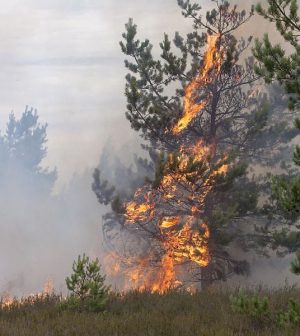- Navigating Your Midlife Crisis: Embracing New Possibilities
- City Raccoons Showing Signs of Domestication
- Mapping the Exposome: Science Broadens Focus to Environmental Disease Triggers
- One Week Less on Social Media Linked to Better Mental Health
- Your Brain Changes in Stages as You Age, Study Finds
- Some Suicide Victims Show No Typical Warning Signs, Study Finds
- ByHeart Formula Faces Lawsuits After Babies Sickened With Botulism
- Switch to Vegan Diet Could Cut Your Greenhouse Gas Emissions in Half
- Regular Bedtime Does Wonders for Blood Pressure
- Dining Alone Could Mean Worse Nutrition for Seniors
Skin Conditions Flare Up When Wildfires Nearby

The smoke billowing from this summer’s devastating wildfires wasn’t just bad for your lungs.
Skin problems also seem to worsen, with dermatology visits rising as air quality deteriorates, a new study says.
Visits for eczema spiked at dermatology clinics within the Mass General Brigham health system during the Canadian wildfires this summer, researchers found.
“We were inspired to investigate the relationship between air pollution and skin inflammation after listening to patients who kept telling us that their skin conditions like eczema were particularly bad, and in some cases ‘worse than ever before,’ this summer,” senior researcher Dr. Arianne Shadi Kourosh said in a news release. She’s director of community health in the Department of Dermatology at Massachusetts General Hospital in Boston.
“This was strange because typically patients with eczema are more likely to experience worsening symptoms or flares in winter months due to cold dry weather, but we were seeing the opposite: an unusual surge in the summer,” Kourosh said.
The MGB hospital system is about 300 miles from the Canadian wildfires, and carbon monoxide (CO) levels peaked in July 2023 as a result of the blaze, researchers found.
Researchers compared dermatology visits in 2019 through 2022 to the summer of 2023, and found that the visits tracked with carbon monoxide (CO) levels in the air.
Wildfire smoke and chronic air pollution contain substances like CO and fine particulates that can trigger a stress response in the skin, leading to inflammation and skin damage, researchers said.
“As wildfire events in North America have been increasing, we must become equipped not only to prevent and extinguish fires, but to also clean or purify our air in order to minimize the negative impacts of these air pollution events on the health of our communities,” lead researcher Kathyana Santiago Mangual of Mass General said in the release.
“Such efforts will have the greatest impact on populations that are most vulnerable to the negative effects of air pollution — including low-income communities, older individuals, and children,” Mangual added.
The findings were published Dec. 16 in the journal Dermatology and Therapy.
More information
The American Academy of Dermatology has more about wildfire smoke’s effects on the skin.
SOURCE: Massachusetts General Hospital, news release, Dec. 18, 2023
Source: HealthDay
Copyright © 2025 HealthDay. All rights reserved.










